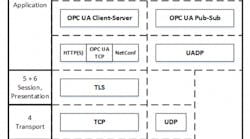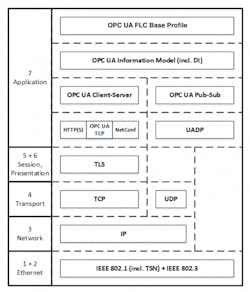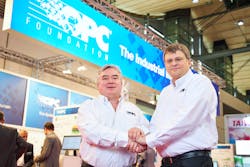Dare to dream of a unified industrial network standard
By Bob Sperber
If manufacturing enterprises could use a single standard for a universal industrial network for all data communications, leaders at every level could stop Googling “Why most digital transformation projects fail.” They would realize the benefits of their Industry 4.0 initiatives much more quickly. The last mile for this kind of network is at the level of data communication all the way down to sensors and devices…at the real-time edge. If incompatible industrial flavors of ethernet and fieldbus networks can be united, sensor-to-cloud connectivity will go far to enhance enterprise-wide visibility and accelerate Industry 4.0 benefits.
To address such hurdles, the dream of a single, universal industrial network is taking shape as two concurrent, complementary technology efforts continue: the extension of the OPC Foundation’s OPC Universal Architecture (OPC UA) framework of information models and data-exchange protocols for field-level communications (FLC); and the addition of time-sensitive networking (TSN) to add low-latency determinism for real-time fieldbus communications using standard ethernet (IEEE 802).
Here are some pertinent details:
• FLC: OPC UA and a publish/subscribe (PubSub) addition to the long-established client/server architecture to extend its cloud and IoT-communication protocols more fully to the field level with deterministic capabilities for hard real-time application. (The first specification is due out before year’s end. See below.)
• TSN: Ethernet’s addition of TSN adds time-sensitive networking (TSN; IEEE 802.1) to the overall ethernet (IEEE 802.x) for deterministic capability to ensure a fixed, predictable timeframe. Most germane to this discussion is a joint IEC/IEEE project (60802): TSN profile for industrial automation that defines which TSN mechanisms become mandatory elements to support multiple protocols sharing one common ethernet TSN network infrastructure.
Related ethernet developments include last year’s Single-pair ethernet (SPE) standard for hazardous environments, expected to be commercialized next year; and Advanced Physical Layer (APL), the latter being key to consolidating field-device network protocols in the process industries. Additionally, OPC UA and TSN will accommodate new ethernet, 802.11/Wi-Fi and 5G standards, the latter eliminating both wired determinism issues and a fair bit of EMF interference—but that topic is for another discussion.
Separate, but concurrent & complementary
OPC UA’s information models and protocols reside at a high level in the networking-technology stack, “riding on top of” a medium such as ethernet (now including TSN) to deliver information models and a standard for multivendor, multi-platform data exchange from sensors to enterprise IT and the cloud. Therefore these two concurrent and complementary technologies do not overlap, as is evident bythe locations of protocols and services used in the traditional seven-layer ISO/OSI Reference Model.
The separate-but-complimentary roles of OPC UA FLC and TSN are evident bythe locations of protocols and services in the seven-layer ISO/OSI Reference Model.
Ethernet with TSN defines Levels 1 and 2 of that model. Traditionally, ethernet defined the Level 1 Physical Layer, which concerns itself with specifications for hardware cables, cards and the physical aspects of sending and receiving data. TSN adds Layer 2 Data Link layer services, such as data packet encoding/decoding, transmission and additional functions such as time synchronization and worst-case latency for applications that require deterministic connectivity. (Fieldbus specifications typically omit Layers 3 through 6.)
These concurrent developments, with seemingly unanimous automation-industry support, bring full IT/OT data communication from the realm of a dream to something more of a long-term vision that can be seen as: “Standard ethernet, a common mechanism for deterministic performance, and a single communications protocol for all devices,” according to David Humphrey, research director, ARC Europe.
While he says the industry has a track record of “not being very good” at rallying around a single standard, he also believes that it’s “hard to recall a time when so much of the industry was pulling in the same direction at the same time.”
OPC’s journey toward the field with TSN
One reason the industry seems to be rallying around what could someday become a single network is that ethernet and OPC UA are universally well-regarded. From the start, OPC Foundation provided a data-exchange protocol that was universally accepted for a lingua franca for data exchange. For years, OPC UA’s client/server model has provided interoperable peer-to-peer communication between controls, computers software systems from the factory floor to business apps and the cloud.
Early on, in 2012, ZWAV, a joint water and wastewater utility serving 40 cities in the Vogtland region of Germany, used OPC UA embedded in remote PLCs to bring control data to the cloud. Silvio Merz, technical manager for the project, said it streamlined engineering efforts and provided “savings on the initial licensing costs of “more than 90 percent per device.” Much has changed since then, but leading organizations look forward to a day when competing vendors and ethernet organizations can settle their competitive differences.
“There’s definite progress towards industry standard communications protocols compared to the early networking days when each supplier had their own proprietary protocol,” says Don Bartusiak, chief engineer, process control, ExxonMobil research & engineering. “However, industrial controls—process and discrete—are converging much slower than telecommunications and IT computing.” Aside from underutilization of digital technologies by end users, he cites competitive issues between industrial ethernet/fieldbus organizations as a key hindrance for which OPC UA may be a solution.
In contrast, the OPC Foundation is powerful and growing, according to Bartusiak, who adds,“OPC UA seems to be among the very few things that otherwise warring suppliers can agree on.”
OPC UA’s evolution has continued. Its use has traditionally been limited to handling non-time-critical tasks such as process-monitoring, sending production recipe data from ERP to HMI/SCADA apps and, providing performance-management data to the cloud. The “hard” real-time communication has been left to industrial ethernet/fieldbus organizations, but this is changing with TSN and new OPC UA specifications that could soon be embedded into field devices.
The addition of PubSub architecture to OPC UA introduced “many-to-many” communication between devices from field to OT and IT systems and the cloud. This officially became the 14th standard of the OPC UA specification in 2018.
Also in 2018, after years of slow-brewing, OPC’s Field Level Communication Initiative (FLC) was formally announced at the SPS IPC DRIVES fair 2018 in Nuremberg. The OPC Foundation’s FLC initiative gained support from the start by 26 members, including the prime movers behind the half-dozen largest industrial ethernet/fieldbus protocol organizations:
• BECKHOFF (ETG/EtherCAT Technology Group)
• Bosch Rexroth (Sercos International)
• B&R (EPSG / Ethernet POWERLINK Standardization Group)
• Mitsubishi Electric (CC-Link Partner Association)
• Rockwell Automation (ODVA)
• Siemens (PI North America, one of 27 regional groups worldwide)
Many of these industry providers and organizations are involved in related, deterministic-product launches, specifications and provisional solutions, sometimes in tandem. TSN product and product lines keep coming, and so do deterministic real-time developments.
For example, June’s joint announcement by OPC Foundation, ODVA and Sercos brought news of a new OPC Motion extension to the OPC UA Framework to give users interoperability across devices using both network protocols for motion control. (A common information model allows direct connectivity between PLCs, motion controllers, all manner of drives, motion encoders, starters, and power supplies in a mixed-protocol environment.)
OPC Foundation’s Peter Lutz, director of the Field Level Initiative (left) and Stefan Hoppe, president and executive director.
By the time such announcements were made official, industry leaders were already working together inside and beyond the OPC foundation to advance the efficacy of OPC UA over TSN.
In 2016, B&R along with real-time networking firm TTTech Industrial and a large group of automation and IT vendors began developing OPC UA over TSN. Among their activities were an informal R&D “Shapers” group, three of whose members—B&R's parent ABB, Rockwell Automation, and Schneider—joined the OPC Foundation’s board. Additional Board members include Beckhoff, Honeywell, Microsoft, Mitsubishi, SAP and Siemens.
Also since 2016, the IIC has collaborated with the OPC Foundation and Avnu Alliance, a consortium working on TSN interoperability, with at least 20 industry solution providers in activities from workshops, IIC testbeds and demonstrations at expos including SPS IPC Drives and Hannover Messe. Add the Alliance of Industrial Internet (AII), Edge Computing Consortium (ECC) and, essentially, every leading industrial-automation vendor, and it’s assured that IoT benefits from sensor to cloud will be increasingly more efficient and effective for industrial end users.
OPC news for field-level communications
The FLC initiative is moving ahead with specifications that, for the first time, brings OPC UA interoperability at the field level to devices such as remote IO, safety devices, servo drives, sensors/actuators, camera systems and other real-time instrumentation. The scope of FLC use standards and use cases for safe, secure, deterministic and interoperable communications is as follows:
• Controller-to-controller (C2C)
• Controller-to device (C2D)
• Device-to-device (D2D)
OPC UA already covers controller-to-controller communication, but relies on existent field buses for the last mile. Also, OPC already established higher-level compute-to-compute communication from plant automation to enterprise to the cloud, however use cases will certainly expand as FLC standards emerge.
The latest news is that the “release candidate” specifications for C2C will be available by the end of October, and will see its final publication after verification and prototype testing by the end of the year. It will support connections between multiple controllers of any make and type (e.g., PLC, DCS, and controls for CNCs, robots and machine tools).
“This is the first milestone of our FLC initiative to define how C2C works in a standardized, vendor-independent manner,” says Peter Lutz, director of the initiative and former managing director of Sercos International. The second specification for controller-to-device (C2D) communications will follow, using and extending C2C models and nomenclature. It will arrive roughly 12 months after the publication of the first spec.
To support IT/OT convergence, the C2C and C2D standards will support full, bidirectional OT/IT connectivity between devices, controllers and computers, Lutz says, including support for “direct, bidirectional connectivity between any IT system and any OPC UA device, even directly to field devices across all applications, software, gateways, edge computers, even the cloud.”
This will establish a single vendor-independent format that will let data scientists directly access data from the lowest-level edge devices for analytics at the highest levels of the enterprise. Says Lutz, “This is actually the big vision we have for the benefits of OPC UA plus TSN. It is probably the most important use case for Industry 4.0 and IoT.”
The participation of IT members underscores the importance of FLC efforts to the Foundation’s IT members’ efforts to bring Industry 4.0 technology to fruition. In addition to Microsoft and SAP, Google Cloud joined the ranks of the about-775-member OPC Foundation in June. “OPC UA will be our way of incorporating machine data into our data analytics and AI capabilities,” explains to Dominik Wee, managing director for manufacturing, industrial and transportation.
Will OPC UA + TSN replace current industrial Ethernet/fieldbus standards?
Technically speaking (all competitive market-driven concerns aside) OPC UA with TSN could eventually replace currently competing industrial ethernet and fieldbus specifications.
OPC UA has long solved many real-time automation use cases employing ethernet, especially in process automation. The addition of TSN adds the determinism needed to for virtually all industrial-automation use cases. Specifically, by providing deterministic latency as low as 1 ms for a controller to read an input and set a device output, the answer appears to be a qualified yes, Humphries says, for “nearly all industrial applications” from process to discrete use cases, even including motion-control applications “in which several dozen to a few hundred axes are coordinated.”
Adding FLC completes the package for a converged, universal network as the as needs of Industry 4.0 drive demand across industrial enterprises. One practical solution is for vendors to offer their customer a choice by embedding a second chip alongside the “classic” protocol offerings in their devices—and ultimately a single chip as migration and new product development proceeds apace.
End-user adoption can follow in the same vein, gradually migrating with new pilots, smaller processes and isolated lines vs. costly rip-and-replace projects at brownfield sites—for which there is “almost never justification,” says ExxonMobil’s Bartusiak . “We'll see a single network in greenfield construction decades before a single network will have significant market share in currently existing facilities.” The good news? “I think we’re two to five years away from a transition for greenfield construction.”
“What we have is a double whammy of OPC as at truly universal protocol and TSN as a truly universal timing mechanism. Both of these perform their best and are predestined to run on standard ethernet, and not on one of the special, modified versions,” says Humphries. He believes this unified network approach “should eventually become the only mechanism. We aren’t there yet by a long shot, but we’re off to a good start.”
Maybe in another decade the industry will gain clear 2030 vision to enable full data visibility and the true benefits of digital transformation.





